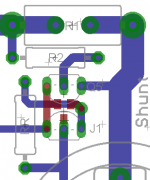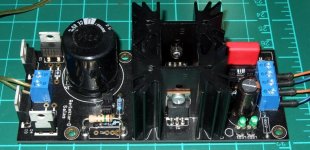This is a GB for Salas Reflektor-D and Reflektor-Mini Power supply.
This is a Low Voltage supply designed specifically for digital.
3.3V to 7V at 600mA max output using board level sinks.
Schematic and build info in PDF attachment at the bottom of post.

In the words of Salas -
The Reflektor concept is a shunt voltage regulator made around a current mirror circuit. To keep equal current between its input and output legs, the mirror reacts to flow disturbances and drives a MOSFET in opposite direction. A current loop simple regulator is another way to describe it. Specifically Reflektor-D is a version focusing on the voltage region common for powering digital source projects. For convenient mounting and setting it utilizes board level sinks and simple ways to choose its current limit and voltage output levels
The board is offered in a Matte Black 2MM thick PCB with 2 OZ copper. The cost is $16.00 plus shipping.

It was a very easy build, it took me 45 minutes to complete and then start testing, and got near target voltages rather easily via the LED swaps.
Three different kits will be offered. A transistor kit, a resistor kit, and a full kit, which includes all parts for board except standoff parts and MOSFET bolts and nuts for the heatsink.

The Reflektor-Mini was created to be installed into some tight spots. It is a much smaller board that will require its MOSFETS to be chassis mounted and electrically isolated for sinking. It keeps a lower height profile too. It is DC input only, needs an incoming DC feed.
It uses a J2 2SK117GR to stabilize and tune output voltage. For keeping small size It has a conventional 2Pin output. It's a slightly more complicated build than the original in some aspects and simpler in some other, but will serve it purposes in being a potentially lower cost unit to construct, as well as a smaller footprint.


In conjunction with the Mini release, the DC Flexy board is introduced. It allows for use of industry standard Snap-in Elcos or 4 pin/pole Mundrorf M-Lytic AG+. These boards can be used as Raw DC units to front end the power supply for the Reflektor-D Mini. They come in a breakable pair so to be used in double mono or multi isolated configurations of more than one regulator to feed. if used in a system of one regulator only, the spare may be broken off and kept aside since it can be utilized in a variety of projects needing Raw DC. Even for the standard Reflektor-D when done in its DC input mode version.

The signup for the boards is in my signature.
This is a Low Voltage supply designed specifically for digital.
3.3V to 7V at 600mA max output using board level sinks.
Schematic and build info in PDF attachment at the bottom of post.

In the words of Salas -
The Reflektor concept is a shunt voltage regulator made around a current mirror circuit. To keep equal current between its input and output legs, the mirror reacts to flow disturbances and drives a MOSFET in opposite direction. A current loop simple regulator is another way to describe it. Specifically Reflektor-D is a version focusing on the voltage region common for powering digital source projects. For convenient mounting and setting it utilizes board level sinks and simple ways to choose its current limit and voltage output levels
The board is offered in a Matte Black 2MM thick PCB with 2 OZ copper. The cost is $16.00 plus shipping.

It was a very easy build, it took me 45 minutes to complete and then start testing, and got near target voltages rather easily via the LED swaps.
Three different kits will be offered. A transistor kit, a resistor kit, and a full kit, which includes all parts for board except standoff parts and MOSFET bolts and nuts for the heatsink.

The Reflektor-Mini was created to be installed into some tight spots. It is a much smaller board that will require its MOSFETS to be chassis mounted and electrically isolated for sinking. It keeps a lower height profile too. It is DC input only, needs an incoming DC feed.
It uses a J2 2SK117GR to stabilize and tune output voltage. For keeping small size It has a conventional 2Pin output. It's a slightly more complicated build than the original in some aspects and simpler in some other, but will serve it purposes in being a potentially lower cost unit to construct, as well as a smaller footprint.
In conjunction with the Mini release, the DC Flexy board is introduced. It allows for use of industry standard Snap-in Elcos or 4 pin/pole Mundrorf M-Lytic AG+. These boards can be used as Raw DC units to front end the power supply for the Reflektor-D Mini. They come in a breakable pair so to be used in double mono or multi isolated configurations of more than one regulator to feed. if used in a system of one regulator only, the spare may be broken off and kept aside since it can be utilized in a variety of projects needing Raw DC. Even for the standard Reflektor-D when done in its DC input mode version.

The signup for the boards is in my signature.
Attachments
Last edited:
There is a modern Toshiba SMD equivalent mentιoned in the guide, also special pads for it (red flats in the pic), and info on what RR value if GR or BL for both TO-92 and SMD. Avoid eBay especially for semis. There are pads for fancy R1 and R6 too. Caddock MP930 and Vishay VAR. Those two parts can cost as much as all the semis and all the nice 50ppm-100pm resistors together though. But don't build with generic passives either. At least at the quality level listed and tested already.I don't even have a DAC and i want a pair of these! Other than the 2SK117s, are any of the parts hard to source? Since I'm not in a rush I might enjoy getting the parts myself.
Attachments
Hello Mike
I would like a precision. If i want all the parts ,i need:
The PCB
The Transistor Kit
The Resistor Kit
The FULL KIT EXTRAS
Thanks
Serge
Ok, I put you on the spreadsheet. The Full kit includes the Transistors and resistors. I will try to clarify that better.
There is a modern Toshiba SMD equivalent mentιoned in the guide, also special pads for it (red flats in the pic), and info on what RR value if GR or BL for both TO-92 and SMD. Avoid eBay especially for semis.
Yes, order yourself some Toshiba 2SK880GRs. If you look closely, mine is running one on an adapter board, only because it was previously being tested that way also in a BIB, and I could desolder quickly for another couple I had at different IDSS values. They are difficult to work with, as they are very small, but with some tweezers, no jitters, and a little solder they go on fine. If I can do it, probably most can. I am uncoordinated and most certainly half-blind from mid-life old age
Last edited:
Salas wrote that maximum V is about 7V. Could it be forced to 8V without risk? What changes needs to be done in that case?
Regards
It could, but takes a longish answer, better we discuss technical details in the simplistic regulators thread in power supplies section, or later on in a dedicated Reflektor-D builders thread when the builds will start.
Here is a side shot of my own test build too. Keep in mind that some pad details will be produced as on the first rendering in post one. So to can fit VAR R6, MP930 R1, third LED for 7V pre-reg use, 5mm & 7.5mm pitch C2 etc. Will also have the two extra ventilation holes at the sinks inside pcb floor area.
Attachments
I have added the kit parts to the master list of Salas kits I will carry in below link.
http://www.diyaudio.com/forums/blogs/tea-bag/741-salas-board-minikits-full-kits.html
Let me know if there are any questions!!
http://www.diyaudio.com/forums/blogs/tea-bag/741-salas-board-minikits-full-kits.html
Let me know if there are any questions!!
Teabag, please add me to your spreadsheet. I had some problems when I tried to do it. I was able to undo my errors.
2 boards
2 Full kits
Thanks
Jim
Done Jim.
If anyone else has problems editing the spreadsheet, let me know.
One board design can not cover all applications in terms of Vref range and dissipation scheme, while being simple to install and set at the same time on "pre-fab" instructed modes. Especially true for a "super shunt regulator" board (the historic name for CCS biased shunts). Not to present an accordion application based on to be calculated by the builders external sinks and a huge guide with 10 ways to realize it for this and that aim, I focused on covering something the Bib was not aiming specifically at already. i.e. the sub 5V needs and around. It became even more persuasive an idea when I listened to Reflektor powering Subbu V3. A very good result.
- Home
- Group Buys
- GB for Salas Reflektor-D Power Supply for Digital

